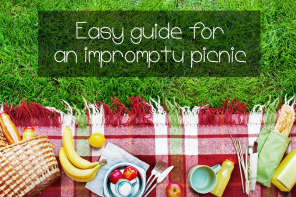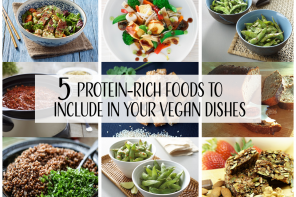A simple and inexpensive way to enjoy the good weather while on vacay is to go camping. Whether it is in Quebec, the US or elsewhere, camping is an activity that a lot of people enjoy. With family, friends or your significant other, there are many kinds of camping you can do. Whether you prefer RV, semi-services or wilderness camping, you’re sure to find something that suits you. It might be easy to find the perfect campsite, but other aspects of an outdoor vacay can be a little more complicated. Bringing food and managing meals are good examples of tasks that require good planning. Not sure what to bring when camping, how to prepare meals in advance and how to store food or are you simply looking for recipes to make at the campsite? Well then, this article is for you!
10 challenges of camping cooking
Challenge 1: Space for bringing equipment is limited
The car is often loaded to the gills when you go on a camping trip. You certainly can’t leave sleeping bags and clothes at home, so to maximize space, choose meals that don’t require many dishes.
Solution: Choose meals that can be cooked in one pot
One pot recipes are becoming more and more popular. Here are a few that will show just why!
Tuna and Vegetable One Pot Pasta
One Pot Chicken Bacon Alfredo Pasta
You certainly know of a pasta dish or two that can be served in one casserole dish, but there are other options:
Source : Guide de survie
One Pan Balsamic Chicken and Veggies
Quinoa with Mushrooms and Shrimp
One Pot Quinoa with BBQ Chicken, Tomatoes, Bell Peppers and Arugula
Want to try something new? Why not make a shakshuka? It’s perfect for breakfast, so can replace your morning oatmeal wonderfully.
Even if you normally make these recipes at home, they’re also easy to do on a camping trip. Whether a portable gas stove or directly on the campfire, you just have to make a few adjustments.
Challenge 2: There’s often not enough room to cook
Space can vary depending on the type of camping you’re doing. Regardless, it’s rare to have as much space as you do at home for meal prep.
Solution: Prepare dishes ahead of time
If you reduce the number of steps required for cooking once on site, the work space available will have less of an impact on the quality of your dishes. Preparing dishes beforehand or doing some of the prep work before leaving makes campsite cooking much easier.
For 20 Make-Ahead Camping Recipes, read this article.
There a many breakfast options. Make this Make-ahead Muesli and Oatmeal Packets or this Almond Granola Recipe . They’re ready to serve whenever you’re ready to eat. If you prefer, whip up a batch of your favourite pancake mix and pour it into a plastic bottle. The only thing left to do is to cook them when you wake up. These asparagus egg muffins and Breakfast Veggie Wraps recipes can both be made in advance and frozen as well. They’ll also help keep the other food cold and are delicious once thawed.
Perfect for lunch or if you’re trying to get the kids to eat more veggies, prepare spreads like these :
To have healthy snacks on hand, it’s a good idea to make muffins or bread. They can be frozen at home and used in the cooler before being enjoyed. Here are a few good recipes to try:
You can even try this Peanut Butter Energy Balls recipe!
For no-cook, hassle-free and satisfying meals, you can also prepare spaghetti or chili sauce before leaving.
Arctic Gardens Spaghetti Sauce
Slow Cooker Chipotle Vegetable Chili
As with several of the recipes mentioned above, you can freeze the amount you want which will also keep your cooler cold. If you prefer, pour into mason jars and seal to then transport them at room temperature.
Do the same with this Green Bean and Mushroom Risotto or these spanakopitas.
What’s better than ending an evening in front of the campfire? Instead of the classic roasted marshmallows, try bannock which is a slightly sweet flatbread that can also be made over the fire. Simplify your life by preparing this Less Mess Bannock recipe in advance.
You can also try this Campfire Bread Recipe. It’s not only delish, but it’ll allow you to enjoy a few more moments with friends or family.
Challenge 3: Sometimes it’s hard to store food properly
Solution 1: Know the shelf life of the food you’re bringing.
To know how long food keeps and how to store it, read our article, Storing Food : 5 Mistakes that are Made Too Often
Solution 2: Choose the right cooler
To properly conserve food, it’s important to choose the right cooler. Depending on the type of camping you’re doing and how long your outdoor vacation lasts, you’ll have to adjust. There are five kinds of coolers:
- plastic
- metal
- Styrofoam
- electric
- fabric or insulated cooler bag
Plastic coolers are really popular because you can pack a lot of food into them and most of the time, they’re easy to transport because they’ve got wheels. The metal ones are more resistant, but aren’t really necessary unless you’re going to do more intense outdoor activities. Styrofoam coolers don’t last long, but they’re not as heavy. Electric coolers can be hooked up to the car and can keep food fresher longer. If your car battery is able to, this kind of cooler is ideal for longer trips.
Finally, fabric or insulated cooler bags hold less food and keep it fresh less long, but they can be practical for day trips or if you can only get to your campsite on foot.
Solution 3 : Use ice
As well as choosing the right cooler, it’s essential to use ice to keep food from spoiling. You can always buy more ice near your campsite. Put ice directly into the coolers or leave it in their plastic bag so the food will stay cold longer. Blocks of ice melt more slowly than ice cubes.
You can also use ice packs or buy dry ice. Made from solid CO2, dry ice can be bought at stores that sell gas. This type of ice keeps food cold or frozen for four to five days keeping food cold substantially longer. A cooler with dry ice can be used as a freezer or cooler fridge for food from the other coolers. However, it’s not recommended to use this kind of ice to conserve fruits and veggies.
Challenge 4: Transporting food can be tricky
Solution 1: Organize food in the cooler properly
If you organize the cooler well, it’ll be easier to conserve food and keep drinks cold. Think first of putting food in the reverse order of how you’ll eat it. This way, you won’t have to take everything out every time you need something.
Are you in the habit of putting ice packs at the bottom of the cooler? Don’t be fooled! It’s better to have them on top of food. Heat rises, but cold falls, so you’ll get better refrigeration if you keep the cold on top. For similar tips, read this Ontario Parks article.
Our Essential Guide to a Successful Picnic can be a great help when you’re filling up the cooler. Go directly to the 11 golden rules for the cooler, and you’ll see!
Solution 2: Don’t break the temperature chain
When transporting camping food, this simple rule will serve you well. If you don’t open the coolers too often and you keep the food that needs to be at the same temperature together, it’ll be easier to manage eating it.
Of course, a cooler containing dry ice to keep the ice packs cold is ideal, but as most of us use blocks of ice and ice cubes, you have to plan to get more ice every 48 hours or so.
By freezing some food like we suggested in “Preparing dishes in advance” in the Challenge 2 solution, you’ll be able to limit the effects of the cold chain. Once frozen, jars of spaghetti sauces or prepared dishes will act as cooling blocks until they melt and are ready to be reheated.
If you plan on having drinks, it’s better to transport them in a different cooler to avoid opening the food cooler too often. This way, the cold chain isn’t broken unnecessarily
Challenge 5: Inspiration comes less easily when cooking at the campsite
Once at the campsite, it’s possible that cooking inspiration isn’t there with you. To avoid eating hot dogs every day during your camping vacay, we’ve provided this list of succulent recipes you can cook outdoors. Get inspired by filling up the coolers when you leave on your next trip.
Solution: Discover recipes for camping
For starters, we suggest you consult this 5 Days Camping Menu where you’ll find five camping recipe ideas for each meal of the day.
Here are a few other recipes suggestions to get you started!
These don’t require much equipment:
Vegetable & Prosciutto Frittata
These are satisfying:
Source : SOS Cuisine
Tomato, Havarti and Ravioli Soup
Spaghetti with Clams and Tomatoes
These are made in papillote:
Brussellian Style Grilled Shrimp
Papillote de cabillaud au riz et aux légumes
Filets de tilapia sur nid de tomates et pois chiches
Several recipes done on the barbecue can also be made easily while camping. Read our Guide to a Remarkable Veggie BBQ and see which ones make your mouth water.
Challenge 6: After a long day outside, you don’t always have the time or the inkling to prepare elaborate dishes
Solution 1: Choose simple meals
Even with non-perishable food, you can prepare succulent dishes. You just need to bring a few good ingredients so when it’s time to cook, you’ll have less to do.
Here are a few simple ideas that don’t require any cooking. Just mix the ingredients together or make a sandwich!
- Couscous, canned tomatoes with juice, canned chick peas and veggies
- Cooked pasta or rice, canned shrimp, vegetables and dressing
- Rolled tortilla with canned ham, vegetables and relish
- Rolled pita with canned salmon, cucumber or avocado and dressing
- Canned beans, canned tuna or salmon, veggies and dressing
- Canned chicken, pieces of fruit and dressing
- Tomato pizza, canned tuna and sliced olives
- Rolled tortilla with shrimp, mango, spinach and salsa
Even if it requires cooking on the gas stove, some dishes can be prepared quickly and easily when you’re camping.
- Seasoned rice pouch with canned salmon and peas
- Pasta, sauce in a pouch, canned tuna and broccoli
- Powdered soup and canned beans
- Stir-fried veggies, a little tomato sauce, canned fish or beans, all served in a tortilla or pita
- Tacos or burrito kit, stir-fried veggies and tofu with seasoning, salsa, all served on a tortilla
- Pasta, meat sauce in a jar and veggies
- Cheese fondue (in ready-to-serve packages) with raw veggies and baby potatoes
By bringing some food in cans or pouches, you can make a good meal without sacrificing taste too much. In fact, you can mix dehydrated veggies with pasta and a soup base. Just add water and cook for a quick noodle soup when the time comes.
Another option: use leftovers to create simple and delicious dishes. Try this Chicken Guedille or this Grilled Ham & Cheese Sandwich Loaf for example.
 Source : Noisette & Ciboulette
Source : Noisette & Ciboulette
When you’re camping, do you like to bring a few more kitchen gadgets to make slightly more elaborate meals? Take a look at these 11 easy 3-ingredients dinner ideas. They don’t have many ingredients which will make your life easier at meal time.
Solution 2: Use frozen vegetables
Frozen veggies are a great solution for even faster meal prep when you’re camping. Just make sure not to thaw them too early before cooking.
Some of our side dish recipes for are perfect for camping. You can make them on site or at home beforehand. Just keep the sauce cold and don’t add them until it’s time to eat. Here are a few appetizing suggestions :
California Vegetable Tabbouleh
You can also make main meals starting from frozen veggies to simplify camping meal prep. These recipes will make you want to incorporate our veggies into your own recipes!
Green Bean Spring Rolls and Peanut Butter Sauce
When you’re camping, it’s not uncommon to choose options that aren’t necessarily healthy ones. Ready-to-eat mac and cheese may seem like a good idea for a quick meal on the gas stove, but why not make a homemade mac and cheese before leaving? Our Vegetable Mac & Cheese makes for a great camping meal. If you prepare it at home, you’ll just have to take out the aluminum plates and cover with tinfoil. Keep cool until you’re ready to eat, cook on the campfire coals for 8 to 10 minutes.
 Source : LaurensLatest
Source : LaurensLatest
Don’t really know much about frozen veggies? Read The Whole Truth About Frozen Veggies article to learn more.
Challenge 7: Recipes are missing flavour when you’re camping
Solution: Choose and plan the seasonings you’ll bring
It’s not because you’re camping that you should forget about enjoying tasty dishes. By bringing the necessary seasonings, you’ll be able to make fancier meals even with fewer kitchen tools. Regardless of what’s on the menu, it’s always useful to bring salt, pepper and lemon juice.
Then depending on your preferences and the meals you’re planning to cook, bring additional herbs and spices. To avoid taking up too much space, put the amounts you want in plastic resealable bags or in small containers. You can also prepare spice mixes before leaving.
Consult our Herb and Spice Guide to learn about the best herbs, spices and dishes.
Challenge 8: It can be hard to replace the famous potato chips
Solution: Discover new healthy snack recipes
There are lots of alternatives available to you when it comes to snacks. It’ll only take a few to convince you otherwise!
Roasted chick peas are a good idea. You can buy them already roasted or roast them yourself before going on your camping trip thanks to this recipe.
Source : Chocolate and Zucchini
Instead of buying chips for nachos and dips, try these recipes:
Pistachios, peanuts, almonds and other nuts can also be good substitutes. Check the salt levels though if you buy them seasoned. If you’re not into making them yourself, you can get healthier chips at the grocery store. Here are 4 Healthier Versions of Chips!
Challenge 9: Kids can get impatient during meal prep
Solution: Get them involved in the cooking process
Sometimes kids seem to have less patience during meal prep when you’re camping. Instead of simply opting for meals that can be made quickly, why not get them to help?
Depending on how old they are, you can give them different things to do. This Pull-apart Pizza Bread is the perfect excuse to ask the kids to help make supper. You can definitely take care of the fire, but they can help prepare it and can choose the toppings they like. You can also read 7 Easy Ways to Include Your Kids in The Kitchen to get your kids to participate.
Challenge 10: Planning lunches can be hard
On a camping vacay, many people like to eat lunch outside, so it can get complicated to know what to prepare and when.
Solution : Choose what you’ll have for lunch the night before
By deciding what you want to eat the night before your next trip, you can better plan your lunches. If you decide on sandwiches, prepare the rest of the meal the night before: sides, drinks, that kind of thing. On the day itself, you’ll just put them together. If your kids are old enough, they can even help make them.
If you’d prefer a more extravagant lunch, it’s probably better to make it the night before. If you want a pasta salad, for example, prepare it without the dressing which you’ll pour on top when ready to serve. For lunch ideas that are easy to bring on trips, read our Essential Guide to a Successful Picnic !
Now that these 10 food challenges of camping have been put together, you’re probably better prepared for your next outing in the woods. Continue reading to fine tune your planning.
Ingredients: What to bring on a camping trip
A good way to better your camping trips is to make a list of what you’ll need. Here’s an ingredient lst template that you can use when planning your next trip. By bringing good equipment and good ingredients, you’ll be well on your way.
You’re now a master in the art of camp cooking or maybe you’re ready for your first attempt this summer. Don’t be shy to share your ideas, tricks, advice and questions!

















